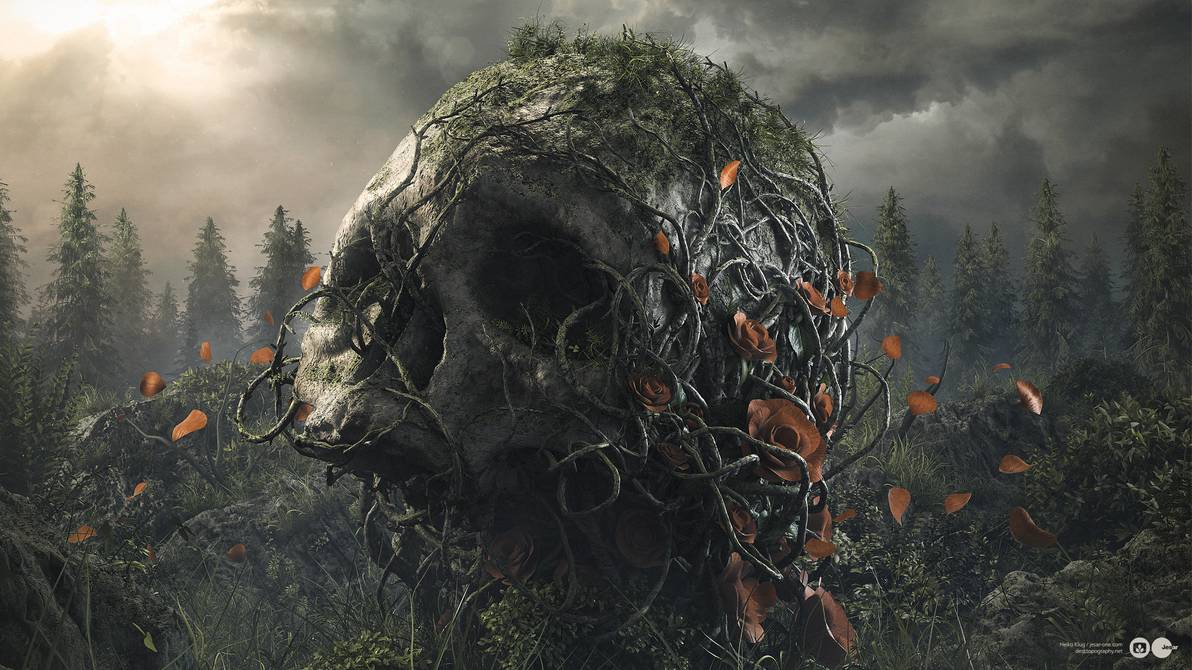Angry Couples
In sickness and in health...
There are many strange examples of flora and fauna around the world. In the desolate and unforgiving land of The Black March, north of Estoya there are two flowers that have grown particularly close.
The symbiotic relationship between The Carrion Tulip and The Javalin Death Daisy is notorious among The Wailing Oaks in The Wailing Wood, who refer to the pairing as Angry Couples.
The symbiotic relationship between The Carrion Tulip and The Javalin Death Daisy is notorious among The Wailing Oaks in The Wailing Wood, who refer to the pairing as Angry Couples.
The Carrion Tulip
The carrion tulip is a brightly colored flower. The bulb is colored purple on the outer edges and blue in the center. The flower was once a highly-coveted alchemical ingredient due to the general health qualities it can provide. It can soothe headaches and cure stomach pains, as well as disinfect wounds. When someone eats the flower they will experience one of the best tasting things they have ever had the experience of eating.
They will be unable to fully describe this taste. There are no analogues to its flavor because the chemical makeup of the flower is specifically designed to activate the taste buds indicating a pleasant taste, when in reality there is no true flavor to the flower.
The stem and leaves are highly toxic and contain a neurological poison that causes paralysis. These evolutionary traits allow it to fill its role in the symbiotic relationship.
They will be unable to fully describe this taste. There are no analogues to its flavor because the chemical makeup of the flower is specifically designed to activate the taste buds indicating a pleasant taste, when in reality there is no true flavor to the flower.
The stem and leaves are highly toxic and contain a neurological poison that causes paralysis. These evolutionary traits allow it to fill its role in the symbiotic relationship.
The Javelin Death Daisy
The Javelin Death Daisy is a breed of megafauna that has adopted an ambush strategy to secure food for itself and its symbiotic partner. It is always colored the same way as the carrion tulip, but is significantly larger. The flower is a massive plume of thick heavy petals around a black "face" that sway as it moves. A large spike fits tightly in a hole at the center of the flower. The spike is made initially of twigs and branches from the couple's surroundings. As the flowers successfully kill prey over time, it will slowly break them down consuming all but the bones. It uses the Bones to either fashion defensive barriers in its log or will fuse and manipulate the bones into more sturdy javelins.
The gases released during its consumption of biological material is stored in the central "heart" of the plant, and provides the propulsion needed for the javelin. The javelin can be shot out at the potential prey with pressures exceeding 9000 PSI.
The gases released during its consumption of biological material is stored in the central "heart" of the plant, and provides the propulsion needed for the javelin. The javelin can be shot out at the potential prey with pressures exceeding 9000 PSI.
Stark contrast
The black March is a desolate land filled with decay. Many animals will immediately try to eat the flower due to its bright colors. Almost everything in the black March is some shade of black white and gray. Such a colorful site would be welcome for many creatures. On top of this, the bright colors can often be seen from a fair distance away, making the process of attracting prey much easier.
The couple can survive for extended periods of time without a successful kill. The carrion tulip can break down biological matter with alarming speed and uses this to feed both itself and its symbiotic partner.
The couple can survive for extended periods of time without a successful kill. The carrion tulip can break down biological matter with alarming speed and uses this to feed both itself and its symbiotic partner.
Symbiosis
The most common way the angry couple can be found is in a fallen tree. The flowers are unable to travel once they root, and require a relatively secure location in order to protect themselves.
The outside of the log will be incredibly well-preserved. The densest logs are often the most preferable. The inside of the log is slowly broken down. This leaves enough room for both flowers to grow their root systems independently. Within the log is the heart, which is a dense compact ball that merges the root systems of both plants.
Any dense material in the surrounding area will be used to cover the heart for an extra layer of protection. It uses the log in a similar way to how other creatures use a shell. Multiple tulips grow and are stored within the log to replace one that is removed. The tulips grow along the log surface through holes they make themselves while the daisy hides inside the logs openings, popping out to attack the prey when the time is right.
The outside of the log will be incredibly well-preserved. The densest logs are often the most preferable. The inside of the log is slowly broken down. This leaves enough room for both flowers to grow their root systems independently. Within the log is the heart, which is a dense compact ball that merges the root systems of both plants.
Any dense material in the surrounding area will be used to cover the heart for an extra layer of protection. It uses the log in a similar way to how other creatures use a shell. Multiple tulips grow and are stored within the log to replace one that is removed. The tulips grow along the log surface through holes they make themselves while the daisy hides inside the logs openings, popping out to attack the prey when the time is right.
In the woods, there is a blue and puple flower. To eat of the flower is to taste heaven, but one must go through hell to do so.
A bad way to go
Some creatures will meet a horrible fate should they accidentally consume parts of the leaf or stem of the carrion tulip. The daisy will not waste a shot when its prey is already defeated, and the paralytic toxin only neutralizes the ability to move. Any creature caught in this predicament will experience the entirety of the process while fully conscious. They will feel the roots enter the body and they will feel the body slowly break down.
by Angelmissme
Dicoverable traits
Wardens can use their abilities to learn of what they encounter. The following are some things that can be learned.
-
The daisy does not have eyes and must rely on a thin spread of a powdery substance found on the pedals of the tulip to successfully shoot its prey. This process is much easier if the prey eats the flower, as the prey will not be able to remove themselves from the daisy's sight. Simply stepping away from the flower can increase the odds of the daisy missing, but the powdery substance will be on the hands and whatever else one's hands have touched.
- The interior pocket of the log is filled with tulips and the heart is always located at the most central point of that log. If damage occurs to the heart, it severs the connection between the two flowers and the daisy will be defenseless and blind.
-
The javelins are made of bone but have been made dense in the fusic process. They make for excellent material in hedgecrafting
-
Seeing the attack coming is an efficient way of making sure it never occurs in the first place. It makes sense that there would be a trigger reaction should somebody interfere with the openings of the log. The daisy will likely fire its javelin on impulse if anyone approaches it. An effective strategy would be to shoot an arrow at the tulip to rouse the daisy and attack it from behind. For the purpose of the RPG if players decide to do this it is an instant kill on the head of the daisy. See large creature rules for details.



Comments